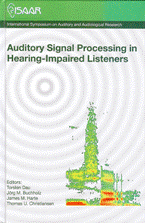Toward an individual-specific model of impaired speech intelligibility
Abstract
Hearing-impaired listeners with similar quiet thresholds often show very different real-world speech intelligibility deficits in listening situations involving competing sounds. The current study is part of larger research project focused on: (1) examining how, and to what extent, these between-subject differences in speech recognition relate to differences in suprathreshold auditory functioning, and (2) on generating accurate, individualized models to predict auditory and auditory-visual speech recognition by hearing-impaired listeners in adverse listening conditions. Individual hearing-impaired and normal-hearing listeners are being tested on a range of psychoacoustic tasks intended to characterize auditory processing sensitivity along a variety of dimensions (frequency selectivity, peripheral compression, traveling wave dispersion, inner hair cell status, spectral and temporal modulation sensitivity and fine-structure processing). Here we report estimates of frequency selectivity and peripheral compression for hearing impaired listeners with similar audiograms and very different per- formance on speech in noise. Comparisons between hearing-impaired and normally-hearing subjects on psychoacoustic measures and their relation to speech recognition in noise will be discussed.
References
Buss, E., Hall, J. W. and Grose, J. H. (2004). “Temporal ne-structure cues to speech and pure tone modulation in observers with sensorineural hearing loss,” Ear. Hear. 25, 242-250.
Chi, T., Gao, Y., Guyton, M. C., Ru, P., and Shamma, S. (1999). “Spectro-temporal modulation transfer functions and speech intelligibility,” J. Acoust. Soc. Am. 106, 2719-2732.
Elhilali, M., Chi, T., and Shamma, S. (2003). “A spectro-temporal modulation index (STMI) for assessment of speech intelligibility,” Speech Comm. 41, 331-348.
Festen, J. M., and Plomp, R. (1990). “Effects of fluctuating noise and interfering speech on the speech-reception threshold for impaired and normal hearing,” J. Acoust. Soc. Am. 88, 1725-1736.
Glasberg, B. R., and Moore, B. C. J. (1989). “Psychoacoustic abilities of subjects with unilateral and bilateral cochlear impairments and their relationship to the ability to understand speech,” Scand. Audiol. Suppl. 32, 1-25.
Gordon-Salant, S., and Fitzgibbons, P., (1997). “Selected cognitive factors and speech recognition performance among young and elderly listeners,” J. Sp. Lang. Hear. Res. 40, 423-431.
Institute of Electrical and Electronic Engineers. (1969). “IEEE Recommended Practice for Speech Quality Measures. IEEE, New York.”
Levitt, H. (1971). “Transformed up-down methods in psychoacoustics,” J. Acoust. Soc. Am. 49, 467-477.
Lopez-Poveda, E. A., and Meddis, R. (2001). “A human nonlinear cochlear filter bank,” J. Acoust. Soc. Am. 110, 3107-3318.
Lopez-Poveda, E. A., Plack, C. J., and Meddis, R. (2003). “Cochlear nonlinearity between 500 and 8000 Hz in listeners with normal hearing,” J. Acoust. Soc. Am. 113, 951-960.
Lorenzi, C., Gilbert, G., Carn, H. Garnier, S. and Moore, B. C. J. (2006). “Speech perception problems of the hearing impaired reflect inability to use temporal fine structure,” Proc. Nat. Acad. Sci. 103, 18666-18669.
Moore, B. C. J. and Skrodzka, E. (2002). “Detection of frequency modulation by hearing-impaired listeners: Effects of carrier frequency, modulation rate, and added amplitude modulation.,” J. Acoust. Soc. Am. 111, 327-335.
Nelson, D. A., Schroder, A. C., and Wojtczak, M. (2001). “A new procedure for measuring peripheral compression in normal-hearing and hearing-impaired listeners,” J. Acoust. Soc. Am. 110, 2045-2064.
Patterson, R. D., Nimmo-Smith, I., Weber, D. L., and Milroy, R. (1982). “The deterioration of hearing with age: Frequency selectivity, the critical ratio, the audiogram, and speech threshold,” J. Acoust. Soc. Am. 72, 1788-1803.
Plomp, R. (1978). “Auditory handicap of hearing impairment and the limited benefit of hearing aids,” J. Acoust. Soc. Am. 63, 533-549.
Rosen, S., and Baker, R.J. (1994). “Characterizing auditory filter nonlinearity,” Hear. Res. 73, 231-243.
Rosen, S., Baker, R.J., and Darling, A. (1998). “Auditory filter nonlinearity at 2 kHz in normal hearing listeners,” J. Acoust. Soc. Am. 103, 2539-2550.
Stone, M. A., Glasberg, B. R., and Moore, B. C. J. (1992). “Simplified measure- ment of auditory filter shapes using the notched-noise method,” Br. J. Audiol. 26, 329-334.
Zilany, M. S. A., and Bruce, I. C. (2007). “Predictions of speech intelligibility with a model of the normal and impaired auditory-periphery,” Proceedings of the 3rd International IEEE/EMBS Conference on Neural Engineering, Kohala Coast, HI, 481-485.
Additional Files
Published
How to Cite
Issue
Section
License
Authors who publish with this journal agree to the following terms:
a. Authors retain copyright* and grant the journal right of first publication with the work simultaneously licensed under a Creative Commons Attribution License that allows others to share the work with an acknowledgement of the work's authorship and initial publication in this journal.
b. Authors are able to enter into separate, additional contractual arrangements for the non-exclusive distribution of the journal's published version of the work (e.g., post it to an institutional repository or publish it in a book), with an acknowledgement of its initial publication in this journal.
c. Authors are permitted and encouraged to post their work online (e.g., in institutional repositories or on their website) prior to and during the submission process, as it can lead to productive exchanges, as well as earlier and greater citation of published work (See The Effect of Open Access).
*From the 2017 issue onward. The Danavox Jubilee Foundation owns the copyright of all articles published in the 1969-2015 issues. However, authors are still allowed to share the work with an acknowledgement of the work's authorship and initial publication in this journal.


